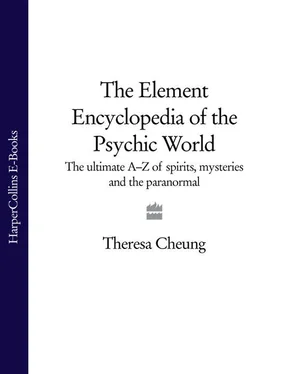7: Psychokinetic potential high - there is less than 8 per cent chance of attaining this score.
6: Psychokinetic potential still likely as this is above chance.
 3-5: Within the area of chance.
3-5: Within the area of chance.
 2: Less than 3 per cent chance of attaining this score.
2: Less than 3 per cent chance of attaining this score.
 1: High psychokinetic potential but working backwards - less than 1 per cent chance of attaining this score.
1: High psychokinetic potential but working backwards - less than 1 per cent chance of attaining this score.
Experimental technique used in psitesting for investigating psychokinesis, the psychic power of the mind to influence objects, in which a subject attempts to influence the fall of dice, for example, by trying to throw more sixes than any other number (chance would give a success rate of 1 in 6 correct throws).
DICKENS, CHARLES [1812–1870]
The author of perhaps the most famous of all ghost stories, A Christmas Carol, Dickens also wrote a number of less-well-known ghost stories, including The Haunted Man and The Haunted House. As well as writing about the paranormalDickens held a tremendous interest in the study of ghostsand spirits. He went to extraordinary lengths to gain access to some of Britain’s hauntinghotspots to experience the unknown for himself.
A form of divinationwhere a question is asked and a dictionary opened at random. The first word seen is interpreted as an answer or comment to the question asked.
See also Bibliomancy.
Reports by two Englishwomen on a seaside holiday at Puys, Dieppe in France of ghostly sounds from the World War II air and sea battle fought at Dieppe. The case was widely documented in the 1950s by paranormalinvestigators and is thought to be an example of collective auditory hallucinations.
On the morning of 4 August 1951 both women were awakened by loud noises of gunfire, shellfire and men shouting and crying out. The women could find nothing to account for the noises and later, when they asked if other people had heard anything, they got negative replies.
The accounts they gave of the sounds and noises showed strong consistencies with a fierce battle that took place in Dieppe on 19 August 1942. Although the women knew a battle had taken place there, they knew none of the details and the information in the guidebook was not enough to match their description to the real event. When interviewed by psychical researchers the women came across as well balanced and with no desire to court publicity. Sceptics proposed other explanations for the experience, such as noise from the surf or aeroplanes flying above, but none of these could explain the remarkable accuracy of the accounts the women gave.
The independent speaking of a spiritvoice that does not seem to emanate from any living person in a given environment and without using the medium’s vocal cords. Commonly associated with the séancesof the early Spiritualistmovement, direct voices seem to come from out of thin air or through a medium’s trumpet, which was specifically used for this purpose. Most early spiritualists used direct voice communication, although some, like Ohio farmer Jonathan Koons, whose spirit room was famous in the 1850s for voices that sang ‘unearthly songs’, were more proficient at it than others. According to some spiritualists the voices were made possible by an artificial voice box, constructed by spirits and activated by ectoplasm.
Nineteenth-century records of direct voices talking at the same time as the medium or from different locations attest to their authenticity, but direct voice mediumship was always at risk of being exposed as ventriloquist fraud. In the twentieth century the practice became very rare indeed, with most mediums receiving information from spirits and relaying in their own voices. However from the 1940s to the 1970s medium Leslie Flintof England became famous for giving what appeared to be genuine direct voice readings. Flint was investigated and tested by several psychical researchers but the possibility of fraud was ruled out. The most dramatic test took place in 1970 in New York, when Flint’s mouth was sealed with plaster and a microphone placed down his throat. No evidence of vocal activity could be found while direct voices seemed to speak from above and slightly to the left of his head.
DISCARNATE ENTITY/DISEMBODIED SPIRIT
Terms used to describe a spirit, ghost, or other non-physical or non-material entity contacted during a séanceor other sitting by a medium. Discarnate entities once had an earthly body (incarnate existence) but now they are dead they have become discarnate - from the Latin dis ‘without’ and caro, ‘flesh’. This is in contrast to other entities, which have just existed in the spirit realm. They are called ‘disembodied spirits’.
DISNEYLAND’s HAUNTED MANSION
In the early 1960s Walt Disney began developing plans for a mansion using secrets of the magic trade to create illusions of ghostsand spirits. In 1966 when Disney died, building work halted, but the attraction finally opened in 1969. There have been several sightings of ghosts over the years and many believe that real ghosts haunt the place.
One of these ghosts is thought to be that of a man who died when his plane crashed in a nearby lake. Referred to by employees as ‘the man with the cane’, he is often seen late at night, especially after closing.
Another spirit is the so-called ‘Man in a tuxedo’, who is said to occasionally appear as a reflection in the mirror used by attendants to see visitors in the area where they disembark. One female employee resigned immediately after seeing the figure of a man wearing a tuxedo in the mirror when there was no one present to create a reflection. She also reported feeling a chill and a hand placed on her shoulder.
Another ghost sometimes seen is said to be a crying boy near the exit. According to legend his mother scattered his ashes secretly inside the Mansion when Disney officials forbade it, and it seems this isn’t what the little boy wanted.
Sceptics argue that the artificially created haunted atmosphere of the place triggers the imagination and creates illusions that seem real. It’s also possible that Disney and his design team threw in a few secrets and surprises to baffle tourists, but most people who visit the haunted mansion find the experience unusually chilling and eerie.
First documented in 1939 by Cambridge University psychical researcher Whitely Carrington, and now observed as a common occurrence, displacement is lack of synchronization in psitesting. For example, a person asked to give the order of a pack of playing cards or ESP cardsmay be one or two cards ahead or behind in sequence. Displacement also occurs in pre-cognitive dreamsand psychicreadings, when difficult or challenging information is placed out of context or buried in non-threatening information or symbols.
Читать дальше

 3-5: Within the area of chance.
3-5: Within the area of chance.
![Theresa Cheung - The Dream Dictionary from A to Z [Revised edition] - The Ultimate A–Z to Interpret the Secrets of Your Dreams](/books/692092/theresa-cheung-the-dream-dictionary-from-a-to-z-r-thumb.webp)









